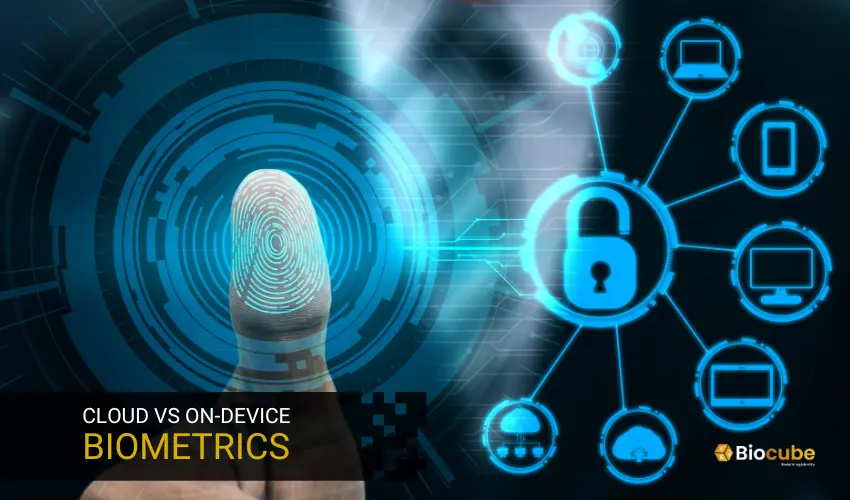
Cloud vs on-device biometrics: Organizational stakeholders often consider choosing a cloud or device-based biometric system when revamping their security. However, the decision is often unclear and depends on the potential advantages the organization seeks.
However, recent news about stolen biometrics from biometric attendance systems has made this choice even more questionable. In January 2024, India Today published an article stating that Chinese microchips and hardware were detected in the Indian government’s Biometric Attendance System (BAS).
The report further stated that nearly a dozen Indian firms provided these systems, and approximately 7,500 state and central government organizations have become subject to biometric data leaks.
Must Read | How Biometrics Enhance Cyber Security?
This could target 900,000 central and 1.7 million state workers who were using more than 80,000 such systems. The risk of data leaks puts the military and defence officers under these establishments at risk. Therefore, it is pertinent to choose the best option based on the criteria we suggest below.
Choosing the Best Biometrics: Cloud-Based vs On-Device Solutions

Selecting the correct option between cloud and on-device biometrics shouldn’t be challenging for anyone once we showcase to you the differences between the two, which are as follows:
Working Functionality
Cloud biometric systems function primarily with a server-side authentication process and remain independent of the device type. On the other hand, on-device biometric authentication happens via a specific device on which the user initially registered.
Therefore, in case the device with stored biometrics is stolen or hacked, anyone could spoof or tamper with it and access banking, financial, and health insurance apps to acquire financial gain by using synthetic biometrics that the service provider can’t recognize.
Security
Cloud biometric systems often include contactless biometrics like face, voice, and even fingerprint. The best ones, like Biocube’s TruNtrance, encompass liveness detection, which means if a person is trying to tamper with or spoof the system to access information, it will send real-time alerts to the administrator to take the next steps.
Moreover, since the biometrics aren’t stored on the device and authenticated from the server side, any malware on the device won’t put the user at risk. Biocube’s attendance system – TruNtrance, has taken a further step to enhance security by incorporating US military-grade AES 256 encryption and Distributed Data Architecture (DDA).
However, some people might disagree, saying that on-device biometric solutions are safer because they are often located within the premises, don’t make data vulnerable to breaches, and are dependent on any number of users.
Also Read | Digital Identity Management: Key Challenges and Solutions
Multimodality
Unlike on-device biometric systems, which often work using a local server and on specified devices, cloud-based biometrics can function on multiple devices, such as laptops, tablets, smartphones, and even CCTV/IP cameras.
Cloud biometric solutions provide remote functionality to the end user, whereas on-device systems may not. They may require the end user to reach the premise and then use the device for access, attendance, and other purposes.
Also Read | Future of Face Recognition Technology
User Experience
In the era of choosing the best technology, people have become prone to upgrade their systems frequently. According to a report, 47% of people replace or upgrade their phones every three years.
Therefore, on-device biometrics don’t seem convenient anymore because, during the resale process, users have to erase the data and re-register with the apps requiring device access and biometrics stored on it.
The risk of a phone being stolen and becoming another reason for purchasing a new device during this time is also exceptionally high and requires undergoing the same stringent process.
On the other hand, cloud-based biometrics provide interoperability, i.e., functionality to work on multiple devices with biometrics securely stored on the cloud. Hence, they give a far superior experience.
Also Read | Passwordless Authentication: All You Need to Know
Speed
On-device biometric systems may also prove to be quicker than cloud systems. They don’t require transmission to the cloud and can even function offline, making them more suitable in areas with low or no internet access.
However, if the specialized biometric hardware fails to recognize the person, they might have to undergo a re-registration process and join the queue to access the premises. A similar case could also happen with the cloud system if it doesn’t recognize the person.
But, the possibility of cloud-based systems offered by Biocube is lower or near negligible because it captures 512 face points, which is sufficient for excellent functionality.
Verdict
Given their working functionality, convenience, user experience, and multimodality, cloud-based biometrics are far superior to on-device biometrics.
However, the choice between an on-device or cloud biometric system depends on government compliances, organizational requirements, working structure, and the need for remote operability.

Conclusion
Selecting between cloud and on-device biometric solutions is challenging; however, it can be made more accessible by selecting the organization’s top requirements. We suggest you opt for cloud-based systems as they offer scalability with remote functionality and interoperability.
Moreover, cloud-based solutions are less prone to data breaches, Distributed Denial of Service (DDoS) attacks, and on-device malware. Therefore, user data remains secure and encrypted, making it unreadable even if accessed.
Also Read | Benefits of Using Biometric Multifactor Authentication
Additionally, cloud-based systems can easily be deployed and have a much higher user base cap. On the other hand, most specialized biometric hardware can store only a few thousand users.
Schedule a call with us today to learn more about the best biometric access and attendance solution for your organization.
